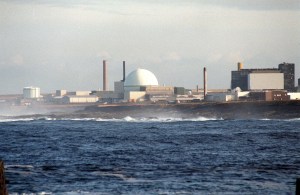
The nuclear fuel reprocessing plant at Dounreay in Scotland
A major new report looking at over three decades of data in the UK has found no evidence that young children living near nuclear power plants face an increased risk of developing leukemia.
However, the report looked only at nuclear power plants during normal operation and so the findings cannot be used to predict the health effects of the Fukushima nuclear disaster.
The “Committee on Medical Aspects of Radiation in the Environment” (COMARE) was established in 1985 to advise the British government on the health effects of radiation. Last year, the UK’s Department of Health asked COMARE to review all childhood leukemia cases around 13 nuclear power plants in Britain as part of safety review following the UK’s decision to build up to eight new nuclear power plants.
Using cancer registration data for Great Britain for the period of 1969 to 1993, COMARE found no increase of childhood leukemia in areas exposed to slightly higher levels of radionuclides from nearby plants: there were only 20 cases of the blood cancer within 3.1 miles of nuclear power stations in 35 years and 430 cases within 15.5 miles. Those figures were similar to the numbers of leukemia cases in sites that had been considered for nuclear power plants, but where construction was never completed. COMARE is independently-funded and, according to its website, “members have never been drawn from the Nuclear or Electrical Power Supply Industries.”
The full report can be dowloaded here.
“We’ve looked as best we can at the potential for radiation around nuclear power plants to cause leukemia and we’ve decided on the best evidence available that it is not the cause,” Professor Alex Elliott, COMARE’s chairman and a clinical physicist at the University of Glasgow, told reporters in London. He added that because leukemia effects only 500 children in the UK each year, “[causation] is something that’s very difficult to study statistically.”
Previous work by COMARE and by other groups of epidemiologists has found that childhood leukemia–and several other cancers–do appear in “clusters.” Some studies have suggested that radiation may be the cause of these abnormally high numbers of cases in localized areas—a German study published in 2008, Kinderkrebe in der Umgebung von Fernkraftwerken, found that living within 3.1 miles of a nuclear power plant doubled the risk of developing childhood leukemia.
But the COMARE report questioned the methodology of that report. “The results are heavily influenced by cases on the earliest period [of the study] (1980-1990) compared with the later periods (1991-1995 and 1996-2003) when the risks are lower,” COMARE said in a press release on its website.
Professor Elliott suggested that further research look elsewhere to explain leukemia clusters, particularly following epidemiological data that suggests leukemia is more likely to strike wealthier children who live in uncrowded rural areas. Even more recent studies suggest that Leukemia may be linked to an infection–possibly a specific virus, or an abnormal response to a routine infection. Some epidemiologist argue that nuclear power plants may be more likely to host leukemia clusters because of the high population turnover in those areas, which would increase people’s exposure to new bacteria and viruses.
In the UK, there are two identified clusters near nuclear installations, but both, Dounreay and Sellafield, are reprocessing plants, not power plants. COMARE’s next report will review the latest evidence for childhood leukemia near them.
As I’ve written before, there is no firm scientific consensus on the health effects of low-dose radiation. Most regulatory agencies around the world–and the IAEA–rely on a mathematical model to estimate radiation risk. Using this model— known as the linear-nonthreshold dose-response model (LNT model)—agencies extrapolate down in a linear fashion from high radiation dose levels known to be harmful. This method results in extremely conservative safety levels—the U.S. Nuclear Regulatory Commission (NRC), for example, sets an acceptable level of radiation exposure from any one source at 100 millirem a year. In contrast, the average level of natural background radiation in the United States is about 350 millirem a year. (A chest X-ray, for further comparison, gives the equivalent to 1 or 2 millirem to the whole body.)
The LNT way of thinking was recently summarized eloquently by Jeffrey Patterson, a professor emeritus in the Department of Family Medicine at the University of Wisconsin School of Medicine and Public Health. Writing in the Bulletin of Atomic Scientists, Patterson says “There is no “safe” or non–harmful level of radiation.” He goes on:
Most of what we know about the effects of radiation exposure comes from studies of the survivors of the Hiroshima and Nagasaki bombings, from intentional medical irradiation, and from a few high-dose accidents. The Hiroshima exposure was a one-time dose largely composed of gamma rays and x-rays, because the bombs were exploded high in the air and produced very little fallout. This type of radiation exposure is very different from…long-lived radionuclides — such as cesium 137, strontium 90, and plutonium 239 — that remain in the environment for hundreds of years. To say that these radionuclides cause no harm to human health is unwarranted; we must observe populations for generations to know what the effects of these releases are.
But some scientists–and many proponents of nuclear power–say that Patterson and other LNT enthusiasts are wrong when they state that there is no “non-harmful” dose of radiation. These scientists argue that there is a threshold below which radiation poses no hazard to health, as cells only slightly damaged by radioactivity can heal themselves without long-term ill effects. They point to studies, like one of tuberculosis patients who had multiple chest X-rays and one of nuclear workers, that showed that the tubercular patients had fewer cases of breast cancer than would be expected and the nuclear workers had a lower mortality rate. (The National Council on Radiation Protection and Measurement, however, has evaluated these and other studies on the protective effects of radiation, and found that they were “insufficient to support” the hypothesis.)


